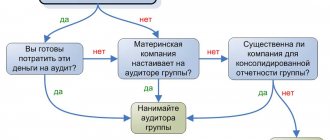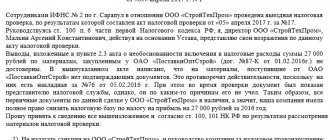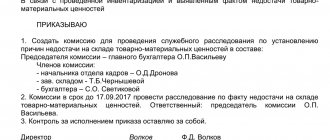- Inventory inventory of fixed assets (form No. INV-1, OKUD 0317001).
- Inventory inventory of intangible assets (No. INV-1a, OKUD 0317002).
- Inventory list of inventory items (Unified form No. INV-3, OKUD 0317004).
- Inventory report of shipped goods and materials (form No. INV-4, OKUD 0317005).
- Inventory list of inventory items accepted for safekeeping (form No. INV-5, OKUD 0317006).
- Inventory report of goods and materials in transit (form No. INV-6, OKUD 0317007).
- Inventory inventory of precious metals contained in parts, semi-finished products, equipment, devices and other products (form No. INV-8a, OKUD 0317009).
- Inventory report of unfinished repairs of fixed assets (form No. INV-10).
Tip #6: Clearly describe the procedures that should be followed as part of internal audit.
Each internal auditor can independently determine control procedures. Some specialists devote more time to accounting methodology, others to the essence of transactions, and still others to checking primary documents. Therefore, it is important to prepare a clear action plan and describe specific procedures. Such procedures include:
Tip #7: Keep up with the times
Legislation and new technologies are constantly being improved and do not stand still; new programs for checking counterparties, new document formats, and new legislative acts are appearing. Therefore, the function of internal control is not only to check accounting and reporting for specific errors, but also to prevent them, therefore the internal control service or a special commission should develop methodological recommendations, indicate changes that an accountant or lawyer can skip due to being busy. For example, from 2020 the procedure for transferring losses will change, which must be reflected in the accounting policies. Regarding the payment of income tax, there is another important amendment related to the transfer of losses. Carrying forward losses until 2020 is possible only in the amount of 50%. But at the same time there is also a positive amendment, so the amount of loss can now be transferred to all subsequent years, and not just within 10 years. In addition, the classification of fixed assets will change. The new classification has been in effect since 2020 and was established by Decree of the Government of the Russian Federation dated July 7, 2016 No. 640. This classification must be applied only to fixed assets that have been put into operation only since 2020. For example, if we purchased a car in 2016, but put it into operation in 2020, then we need to use a new classifier.
Accordingly, all changes must be taken into account by the company's divisions, and the internal control service can take on the warning function.
In conclusion, it is necessary to note that the internal audit service or the corresponding commission is quite important in any company. Internal audit plays a preventive function, significantly reduces the company’s risks, and also allows you to save on external audits, if the latter is not mandatory.
Guidelines for company financial management
fd.ru
Implementation results
- All VA results must be in documented form for subsequent study. Most often, documents mean a summary report or its smaller forms. It indicates not only information about the detected shortcomings, but also the proposed ways to eliminate them. Also, the results of the internal audit necessarily reflect potential ways to improve the efficiency of work processes.
- In addition to drawing up reports and other audit documentation, another procedure is necessary. It is important to clarify in advance the criteria for the effectiveness of the work of inspectors and, upon completion of the internal audit, to analyze the quality of the control performed.
- Often these criteria include compliance with the stated inspection time frame, the presence of complete and clear comments on all points studied, and an indication of potential problems in the future. It is also necessary to analyze the activities of auditors for compliance with inspection regulations and the correct use of various control methods. Another criterion is the availability, completeness and timeliness of providing documentation on the inspection performed.
When conducting an internal audit, a large role is played by its preparation (and do not forget about the checklist!). Without a properly carried out preparatory part, high-quality work by inspectors is impossible. There is no unified audit system; each company independently combines control methods, so it is worth paying special attention to the preparation, the audit itself, and the analysis of the effectiveness of the audit service.
Conducting an internal audit of the management system is described in this video:
Regulatory regulation of internal audit
Auditors conducting internal audits should be guided by the following:
Enterprises that use auditing as a method of self-inspection develop their own local regulations regulating the procedure for carrying out all stages of inspection activities. The basis of the intra-company set of rules is formed by national internal audit standards. The procedure for conducting inspections in companies may differ from generally accepted norms, but should not contradict them. The level of detail of the standards is determined by the management of the enterprise.
Goals and objectives of internal audit
The audit is carried out to resolve a problematic issue, find the source of inconsistencies, and select development paths with the maximum level of efficiency. The purpose of internal audit is to:
Internal audit tasks:
Audits on a regular basis are necessary to reduce the risks of unplanned debts, losses and making unlawful decisions.
Implementation results
- All VA results must be in documented form for subsequent study. Most often, documents mean a summary report or its smaller forms. It indicates not only information about the detected shortcomings, but also the proposed ways to eliminate them. Also, the results of the internal audit necessarily reflect potential ways to improve the efficiency of work processes.
- In addition to drawing up reports and other audit documentation, another procedure is necessary. It is important to clarify in advance the criteria for the effectiveness of the work of inspectors and, upon completion of the internal audit, to analyze the quality of the control performed.
- Often these criteria include compliance with the stated inspection time frame, the presence of complete and clear comments on all points studied, and an indication of potential problems in the future. It is also necessary to analyze the activities of auditors for compliance with inspection regulations and the correct use of various control methods. Another criterion is the availability, completeness and timeliness of providing documentation on the inspection performed.
When conducting an internal audit, a large role is played by its preparation (and do not forget about the checklist!). Without a properly carried out preparatory part, high-quality work by inspectors is impossible. There is no unified audit system; each company independently combines control methods, so it is worth paying special attention to the preparation, the audit itself, and the analysis of the effectiveness of the audit service.
Conducting an internal audit of the management system is described in this video:
Procedure for conducting internal audit
The inspection is initiated by order of the manager. From this moment the preparatory stage of the audit begins. The next step will be the implementation of the working part and the final block of work. Conducting an internal audit at the initial stage implies:
At this stage, local regulations are studied, the results of previous audits are considered, risks are analyzed and a system of indicators is formed that need to be determined for the effectiveness of the audit. If necessary, access to specialized software may be requested. The activity plan should allocate time for interviewing participants in internal production processes.
Internal audit at an enterprise is carried out by persons appointed responsible by the management of the organization. Interested employees are provided with information about the nature of the work to be done, its volume, and specific tasks that must be completed. Job descriptions are developed for each auditor. Their content must comply with the standards included in the current Regulations on Internal Audit.
The working part is to implement audit procedures. They involve collecting facts related to the identified issues. Based on the information obtained, calculations, comparative analyzes are made and value judgments are made. The audit report will be based on them.
In the course of their activities, inspectors may use the following internal audit methods:
Through testing, internal audit can assess the level of reliability of the existing control system and management model. The result of the inspection is a report that records the full range of identified deficiencies and errors, provides recommendations for their elimination and preventive advice.
spmag.ru
HR audit
The concept of audit in personnel work, as in accounting, comes down to checking the documentation stored in the personnel department and the company archive.
If all documents are in perfect condition, the employer can calmly prepare for inspections and not be afraid of fines for incorrect execution of work books and orders, unfilled accounting journals or the absence of mandatory regulations.
A thorough audit of personnel documents is not the easiest or fastest procedure, but it is necessary. This is the only way to identify weaknesses in working with personnel that could potentially cause a labor dispute or cause criticism from the State Labor Inspectorate.
What kind of check is there?
- Full. Covers the entire scope of personnel documentation and allows you to get a general idea of how the company maintains personnel records.
- Selective. Covers certain aspects of office work.
A full HR audit involves three types of work:
- Examination of existing documents.
- Checking for the presence of a complete set of documents required by law.
- Checking high-risk segments.
Traditionally, high-risk segments include everything related to the preparation of a large volume of documents, obtaining permits, and special attention from state control authorities.
For example, labor relations with foreigners and teenagers, overtime pay, involvement in work on weekends and holidays, agreements on full financial responsibility, the rights of women and people with family responsibilities.
Particular attention is paid to work books, agreements and contracts.
Personnel audit training Take an 8-hour training course “Audit of personnel documentation on your own” at the Higher School of Personnel Management to quickly put things in order!
How often should an organization's HR audit be conducted?
Conduct audits as needed. An ideal option for a large or medium-sized enterprise is regular scheduled checks of the status and availability of personnel documents, not tied to external events.
Determine the frequency of events taking into account objective indicators: the volume of documentation to be audited, the number of personnel and other nuances of production activities.
But sometimes conducting a personnel audit is a necessary measure.
Be sure to conduct a personnel audit:
- when changing the official responsible for personnel records management;
- after a conflictual dismissal, if a former employee threatens to sue;
- with massive staff reductions;
- before a scheduled GIT inspection;
- when there is a change in the general director or owner of the company.
Do not accept cases without a thorough audit when applying for a responsible position in the HR department.
If it is not possible to arrange the acceptance and transfer of cases jointly with your predecessor, who was previously responsible for personnel records, listen to the advice of an experienced personnel officer: an expert from the magazine “Personnel Business” will tell you where to start working with documents so as not to be responsible for the mistakes of former personnel officers
Please note that for a high-quality check of all documents, even in a small organization, it will take from 7 to 14 working days, and for a selective audit - at least 3-7 working days. Do not try to conduct an audit in record time: excessive haste is fraught with errors, inattention to the matter and errors in reports.
How to conduct a personnel audit on your own: step-by-step instructions
Audit can be external or internal. To conduct an external audit, third-party specialists are invited - independent auditors or employees of audit companies.
In this case, all that is required from the employer is to provide auditors and consultants with access to documents and pay for their services.
The results of professional expertise allow us to objectively assess the quality of personnel records in an organization.
It is easier and more profitable for small enterprises to conduct personnel audits on their own. If the volume of work is large and audits are carried out frequently, you can create a full-time auditor position or an internal control unit. Persons responsible for carrying out one-time events are appointed by order of the head from among the personnel or legal department employees.
A personnel audit will help not only prepare for the inspection of the State Labor Inspectorate and meet the inspector fully armed, but also evaluate the effectiveness of the personnel service as a whole, since record keeping is one of the most important aspects of its work. An expert from Sistema Personnel will tell you more about the methods, goals and tools of such an assessment.
How to conduct a HR audit: 5 steps
Step 1: Determine your main objectives. This can be either individual areas of personnel records or documents for specific employees, or work with personnel in general. Typically, a personnel audit begins with a check of local regulations, which the employer must have.
Step 2. Issue an order to conduct a personnel audit. Specify the purpose of the audit and establish a special commission. Entrust the audit only to employees who have a good knowledge of labor laws, for example, a company lawyer, chief accountant or leading HR specialist. Be sure to set a deadline by which the commission must report on the results of the activities carried out.
Sample order for an audit: deadline for submitting a report
Step 3. Determine the list of documents to be checked. If the topic of the audit is specified by order, prepare all documents relevant to the case.
Step 4. Check and reconcile each document. It is important to make sure not only that the documents are available, but also that they fully comply with the requirements of labor legislation. First, find all the documents reflected in the list, and then check their content and quality of execution.
Make a table with three columns:
- "Document missing"
- “The document is available, but requires changes,”
- “The document is available and fully complies with the law.”
Then, checking the documents from the list, distribute them according to the table so that when processing the results you clearly understand what is missing and what needs improvement.
Step 5. Document the test results. Prepare a written report or expert opinion certified by all members of the commission. The report should not only reflect the current state of personnel records management, but also contain practical recommendations for correcting the situation, if necessary. Indicate specific ways to eliminate violations.
Audit report (fragment): recommendations for eliminating violations
Order on conducting an internal audit of compliance with labor protection requirements
Limited Liability Company "Beta" LLC "Beta"
On conducting an internal audit of compliance with labor protection requirements
To improve the work of the labor protection service and minimize the risks associated with improper organization of labor protection at Beta LLC,
1. Conduct an internal audit of compliance with labor protection requirements using a continuous method in the period from March 11 to March 21, 2014.
2. The commission consisting of the following members will be entrusted with carrying out an internal audit of compliance with labor safety requirements: 1) the chairman of the commission for conducting an internal audit of compliance with labor safety requirements - HR Director V.V. Semenova; 2) members of the commission for conducting internal audit of compliance with labor protection requirements: – Chief Legal Adviser N.N. Zelenin; – HR specialist Ivanova M.E.; – occupational safety specialist Pavlov P.D.; – accountant Yudina S.V.
3. To the head of the labor protection service, K.V. Uvarov. organize work on the preparation of labor protection documentation for inspection and transfer it to the commission for conducting an internal audit of compliance with labor protection requirements by March 11, 2014.
4 . The chairman of the commission for conducting an internal audit of compliance with labor protection requirements, after completing the inspection, shall submit a written report on the results of the internal audit of compliance with labor protection requirements to the General Director of Beta LLC by March 28, 2014.
5 . Control over the implementation of this Order shall be entrusted to the HR Director V.V. Semenova.
General Director _________________________ A.I. Petrov
www.moedelo.org
Inspection order
At the end of the investigation, the commission must issue a special act reflecting the results.
Verification period. The director of the company determines the period during which the investigation must be conducted and sets a date for the commission to sign a report on the results of the inspection.
Who controls the execution of the order to conduct an internal audit. For example, the document may contain the wording
“I entrust control over the execution of the order to the employee (full name and position)”
. Also, the order, if necessary, notes what measures to take in case of specific results.
For example, if documents are missing, but they could not be found, make efforts to restore them. The final part of the document must contain the signature of the director of the company on whose behalf the order is drawn up. The commission members mentioned in the order must also sign.
It should be noted in the document that they have read the contents.
Concept and main purpose of an audit
Audit
— this is an analysis of financial (accounting) reporting data to determine the degree of their reliability and compliance of the accounting procedure with the legislation of the Russian Federation.
The audit is intended to confirm or refute that any users of the financial information contained in the statements will be able, based on it, to draw correct conclusions about the results of economic activity, the financial and property position of the company and make informed decisions based on these conclusions. The main purpose of the audit
is to verify
the reliability
of reporting, and
the main condition for its implementation
is
the independence
of the auditor.
The result of the audit
competent opinion
officially recorded in the prescribed form , that is,
the auditor’s report
.
However, “the user should not accept the auditor’s opinion either as an expression of confidence in the continuity of the audited entity’s activities in the future, or as confirmation of the effectiveness of the management of this entity in conducting business” (Federal Rule (standard) (hereinafter referred to as FSAD) No. 1 “The purpose and basic principles of financial audit (accounting) statements"). This formulation is due to the fact that there are objective and subjective restrictions that affect the likelihood and possibility of identifying significant misstatements of financial information in reporting: testing, the use of sampling methods, imperfections in accounting and internal control in the audited organization, presentation of evidence in the form of arguments to substantiate the conclusion , lack of comprehensive answers. reasonable assurance in the process of obtaining necessary and sufficient evidence to support the audit conclusion.
in the accuracy and reliability of reporting (paragraphs 6–9, FSAD No. 1). The auditor is responsible for formulating and expressing an opinion on the reliability of the statements, and the company's management is responsible for the preparation and presentation of the statements.
The auditor independently decides which quantitative (values) and qualitative (character) distortions in the reporting can be considered significant and which cannot. It sets a kind of bar for acceptable “materiality in an audit”
(FSAD No. 4), which the lower, the higher the risk of auditor error in the conclusion.
Given the above, many clients of audit organizations ask the question: “If distortions, inaccuracies and errors in our financial (accounting) statements are missed, does the auditor always have the excuse of sampling and the established level of materiality?” This understanding of audit procedures is primitive and fundamentally incorrect. The likelihood of an audit error is mitigated by such methods as changing the nature, timing and scope of planned audit procedures, conducting extended or additional tests of controls. Their application and/or modification is based on an assessment of the likely consequences of the misstatements.
in the reporting of the audited entity. In addition, let us recall Vilfredo Pareto’s law: 20% of efforts give 80% of the result, and the remaining 80% of efforts give only 20% of the result. To a certain extent, it reflects the principle of forming an audit sample that includes the most significant information about individual assets, liabilities, income and expenses, business transactions and capital structure. These data may or may not be significant depending on the size of the indicators, frequency, and the nature of their impact on the economic activities of the audited entity. Obviously, the auditor may miss an error, but with a professional selection of samples, this error will not form the main part of the financial indicator and will not be decisive.
Ethical Principles of Auditing
The above, as well as other FSAD norms, as well as federal laws, indicate that audit activities are carried out only by those persons who are professional
and
continuously
engaged in it and are able to confirm their qualifications with the appropriate certificate issued by SRO auditors. In addition, in accordance with the Code of Professional Ethics for Auditors, the auditor is required to comply with basic ethical principles:
mean building business relationships fairly. Thus, if facts are discovered that indicate that the information provided contains materially false or misleading statements or that the data has been carelessly prepared, the auditor is not required to intentionally be associated with such reports, documents, communications or other information, but must take action to eliminating such a connection.
- implies, in particular, that the auditor should avoid relationships or exclude situations that may affect the impartiality of his judgment, for example, if he finds himself in the middle of a conflict of interest of third parties.
and due care means constant professional development, maintaining knowledge and skills at a high qualification level in accordance with the achievements of practice and legislation, conscientious application of auditing standards in the process of providing services.
- obliges the protection and non-dissemination of information obtained during business interaction with the client (except for circumstances specified by law).
- consists of complying with the requirements of current legislation, avoiding actions that may discredit the profession itself or may be regarded by a third informed person as discrediting the reputation of the auditor, audit organization or self-regulatory organization of auditors of which he is a member. Such actions, in addition to the above-mentioned acts of unethical behavior, include disparaging comments about one's colleagues or competitors, drawing unfounded parallels between one's work and the work of other auditors, and statements exaggerating one's own merits when offering and promoting one's candidacy or services.
Sample order to conduct an audit
> > For this reason, there is no single high-quality system for conducting internal audits - each company has its own structure, which forces them to change the control procedure used.
In this case, any auditing system must obey the following principles:
- Uniformity and consistency
- Precaution and documentation.
- Stages and regularity
- Openness and independence
Without taking into account these principles, internal audit cannot be effective. The organization also plays an important role in the positive results of the audit.
On conducting a mandatory audit of the annual accounting (financial) statements of the capital repair fund of the Tula region
In accordance with the minutes of the meeting of the competition commission for the selection of an audit organization (auditor) to conduct a mandatory audit of the annual accounting (financial) statements of the regional operator dated April 20, 2020 No. 2, order of the governor of the Tula region dated April 14, 2020 No. 229-rg " On the annual paid leave of Shevchenko E.V.” I order: 1.
The audit control procedure must be clearly organized to eliminate errors in the work of the auditors themselves. High-quality organization of auditors’ activities makes control simple, fast and effective. Conducting an IA always begins with preparation.
Establish that the mandatory audit of the annual accounting (financial) statements of the Capital Repair Fund of the Tula Region is carried out from April 27, 2020 to May 13, 2020 by the auditing organization AUDIT-Partner LLC, selected based on the results of the competition.2. Approve the contract for the provision of services for conducting an audit of the annual accounting (financial) statements of the regional operator dated April 22, 2020 N 33, concluded between the Capital Repair Fund of the Tula Region and AUDIT-Partner LLC, selected based on the results of the competition (Appendix).3.







